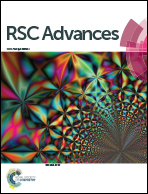Strain-engineering the electronic properties and anisotropy of GeSe2 monolayers†
Abstract
As a new two-dimensional (2D) material, GeSe2 has attracted significant attention recently due to its distinctive in-plane anisotropic properties originated from the in-plane anisotropic crystal structure, high air stability and excellent performance in polarization-sensitive photodetection. However, no systematic study of the strain effect on the electronic properties and anisotropy of GeSe2 has been reported, restricting the relevant applications such as mechanical-electronic devices. Here we investigate the change of the electronic properties and anisotropy of GeSe2 monolayer under strains along x and y directions through first-principle calculations. The electronic band structure and effective mass of charge carriers are highly sensitive to the strain. Notably, through appropriate x or y directional strain, the anisotropy of the hole effective mass can even be rotated by 90°. These plentiful strain-engineering properties of GeSe2 give it many opportunities in novel mechanical-electronic applications.



 Please wait while we load your content...
Please wait while we load your content...